
Sanicula is a genus of plants in family Apiaceae, the same family to which the carrot and parsnip belong. This genus has about 40 species worldwide, with 22 in North America. The common names usually include the terms sanicle or black snakeroot.
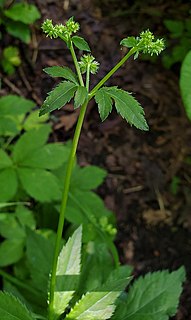
Sanicula canadensis, the Canadian blacksnakeroot, is a native plant of North America and a member of family Apiaceae. It is biennial or perennial, and spreads primarily by seed. It grows from 1 to 4.5 feet tall, and is found in mesic deciduous woodlands. The whitish-green flowers with sepals longer than petals, appearing late spring or early summer and lasting for approximately three weeks, are green and bur-like. The bur-like fruit each split into 2 seeds. The species ranges throughout the eastern United States, extending north into Quebec and Ontario, and west into Texas and Wyoming.

Sanicula bipinnata is a species of plant in the family Apiaceae known by the common name poison sanicle. It is endemic to California where it is found in low-elevation mountains and foothills, especially in the hills along the coast. It occurs in the California Coastal Range and Sierra Nevada foothills, including Ring Mountain, California.
Sanicula laciniata is a flowering plant species of in the family Apiaceae. Common names include coastal blacksnakeroot, laceleaf sanicle, and coast sanicle.

Pyrrocoma apargioides is a species of flowering plant in the family Asteraceae known by the common name alpineflames. It is native to the western United States from the Sierra Nevada of California east to Utah, where it grows in the forests and meadows of high mountains. It is a perennial herb growing from a taproot and producing one or more stems to 30 centimeters in length. The stems are decumbent or upright, reddish, and hairless to slightly woolly. Most of the leaves are located around the base. They are thick and leathery, lance-shaped with large sawteeth along the edges, often center-striped in white, and measure up to 10 centimeters long. The inflorescence is usually a single flower head lined with centimeter-long phyllaries which are reddish to green with red edges. The head has a center of yellow disc florets and a fringe of ray florets which are yellow, often splashed with red along the undersides, measuring up to 1.6 centimeters in length. The fruit is an achene which may be well over a centimeter in length including its pappus.
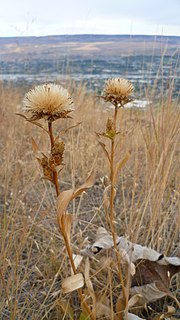
Pyrrocoma carthamoides is a species of flowering plant in the family Asteraceae known by the common name largeflower goldenweed. It is native to western North America from British Columbia to northeastern California to Wyoming, where it is known from grassland, woodlands, forests, barren areas, and other habitat. It is a perennial herb growing from a taproot and producing one or more stems to about half a meter in maximum length, the stems reddish-green and leafy. The largest leaves are at the base of the stem, measuring up to 20 centimeters long, lance-shaped with spiny sawtoothed edges. Leaves higher on the stem are smaller and hairier. The inflorescence is a single flower head or a cluster of up to four. Each bell-shaped head is lined with phyllaries each up to 2 centimeters long. It has many yellow disc florets surrounded by a fringe of yellow ray florets up to 7 millimeters long; ray florets are occasionally absent. The fruit is an achene which may be well over a centimeter in length including its pappus.

Sanicula arguta is a species of flowering plant in the family Apiaceae known by the common names sharptooth sanicle and sharptooth blacksnakeroot.

Sanicula bipinnatifida is a species of flowering plant in the parsley family known by the common names purple sanicle, purple blacksnakeroot, and shoe buttons. It is native to the west coast of North America from British Columbia to Baja California, where it can be found in many types of habitat, including grassland, woodlands, and mountain slopes of serpentine soils. It is a perennial herb growing to a maximum height near 60 centimeters from a taproot. It is bright green to dark purple in color. The leaves are borne on long petioles, measuring up to 19 centimeters long with blades divided into several toothed lobes. The inflorescence is made up of one or more heads of bisexual and male-only flowers with tiny, curving, reddish, purple, or yellow petals. The prickly fruits are a few millimeters long.

Sanicula crassicaulis is a species of flowering plant in the family Apiaceae known by the common names Pacific blacksnakeroot and Pacific sanicle. It is native to the west coast of North America from British Columbia to Baja California, where it can be found in many types of habitat, including mountain slopes, grassland, and woodlands. It is a perennial herb producing a thick stem up to 1.2 meters tall from a taproot. The leaves have blades up to 12 centimeters long which are divided into a few deep lobes and edged with small teeth. The inflorescence is made up of one or more heads of bisexual and male-only flowers with tiny, curving, yellow petals. Each head has approximately five leaflike, lance-shaped bracts at its base. The rounded fruits are a few millimeters long, covered in curving prickles, and borne in small clusters.
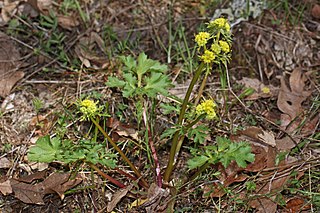
Sanicula graveolens is a species of flowering plant in the family Apiaceae known by the common names northern sanicle and Sierra blacksnakeroot. It is native to western North America from British Columbia to Montana to California, and southern South America, including southern Chile. Its habitat includes mountain slopes, forests, and woodlands on serpentine soils. It is a perennial herb producing a slender, branching stem up to half a meter tall from a taproot, with leaves alternate. The lowest leaves have long stalks and are often attached below ground. The upper leaves are smaller, sparse and often sessile. The leaves are compound, the blades each divided into three deeply lobed, toothed leaflets. The herbage is green to purple-tinged to all purple in color. The inflorescence is made up of one or more heads of bisexual and male-only flowers with tiny, curving, yellow petals. Each head has an array of narrow, toothed bracts at its base. The rounded fruits are a few millimeters long, covered in curving prickles, and borne in small clusters.
Sanicula hoffmannii is an uncommon species of flowering plant in the family Apiaceae known by the common names Hoffmann's blacksnakeroot and Hoffmann's sanicle. It is endemic to California, where it is known from the Channel Islands and a few locations in the coastal mountain ranges of the mainland, including the Scott Creek watershed in Santa Cruz County. Its habitat includes coastal hillsides and mountain slopes, sometimes with serpentine soils. It is a perennial herb producing a thick stem up to 90 centimeters tall from a taproot. The green or bluish leaves are compound, the blades each divided into about three lobed, toothed leaflets. The inflorescence is made up of one or more heads of bisexual and male-only flowers with tiny, curving, yellow-green petals.
Sanicula maritima is a rare species of flowering plant in the parsley family known by the common names adobe snakeroot and adobe sanicle.
Sanicula peckiana is an uncommon species of flowering plant in the family Apiaceae known by the common names Peck's blacksnakeroot and Peck's sanicle. It is native to the Klamath Mountains of southern Oregon and far northern California, where it grows in chaparral and woodland habitat, often on serpentine soils. It is a perennial herb growing to a maximum height near 40 centimeters. The leaves are simple or divided into a number of lobes, the edges generally with sharp teeth. The inflorescence is made up of one or more heads of bisexual and male-only flowers with tiny, curving, yellow petals. The fruits are borne singly or in heads of up to five, each fruit covered in bumpy tubercles and sometimes with prickles near the tip.
Sanicula saxatilis is a rare species of flowering plant in the parsley family known by the common names devil's blacksnakeroot and rock sanicle.

Sanicula tracyi is a species of flowering plant in the family Apiaceae known by the common names Tracy's blacksnakeroot and Tracy's sanicle. It is endemic to northwestern California, where it is known from woodlands and coniferous forest in hills and mountains. It is a perennial herb producing a slender stem up to about 60 centimeters tall from a taproot. The leaves are compound, divided into usually three leaflets which are deeply cut into lobes and serrated along the edges. The herbage is green to purple in color. The inflorescence is made up of one or more heads of bisexual and male-only flowers with tiny, curving, yellow petals. The fruits are 2 or 3 millimeters long, each fruit covered in bumpy tubercles and sometimes with prickles near the tip.
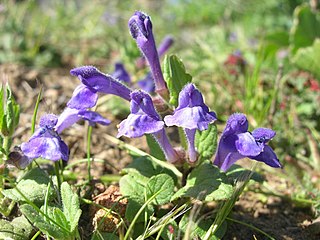
Scutellaria tuberosa is a species of flowering plant in the mint family known by the common name Danny's skullcap. It is native to western North America from Oregon through California to Baja California, where it is widespread throughout the mountain and coastal regions; it is absent from the deserts and the Central Valley of California. It can be found in forest and woodland habitat, and a variety of open habitat types, often appearing in areas recently cleared by wildfire. It is a perennial herb producing an erect stem or cluster of stems up to about 25 centimeters tall from a root system with tubers. The stems are coated in short, spreading hairs. The oval leaves are oppositely arranged. The lowest leaves are borne on short petioles. Flowers emerge from the leaf axils. Each flower is held in a calyx of sepals with a large ridge or dome-shaped appendage on the upper part. The tubular corolla is one to two centimeters long and has a large upper and lower lip. The upper lip is folded into a beaklike protrusion and the lower has three wide lobes. The corolla is deep purple-blue, usually with a white patch or mottling on the lower lip.
Tripterocalyx crux-maltae is a species of flowering plant in the four o'clock family known by the common names Lassen sandverbena and Kellogg's sand-verbena.
Sanicula mariversa is a rare species of flowering plant in the family Apiaceae known by the common name Waianae Range black-snakeroot. It is endemic to Hawaii, where it is known only from the Waianae Mountains on the island of Oahu. It is threatened by the degradation of its habitat. It is a federally listed endangered species of the United States.
Sanicula purpurea is a rare species of flowering plant in the carrot family known by the common names purple-flower black-snakeroot and purple-flowered sanicle. It is endemic to Hawaii, where it is known from Maui and from the Koolau Mountains on the island of Oahu. It is threatened by the degradation of its habitat. It was federally listed as endangered species of the United States in 1996.
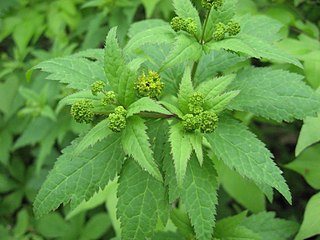
Sanicula odorata, commonly called the clustered blacksnakeroot, is a flowering plant in the family Apiaceae. It is native and widespread in eastern North America. It grows in nutrient-rich woods, often in mesic forests and bottomlands. It is able to tolerate somewhat degraded habitats, and is not considered a particularly conservative species.












